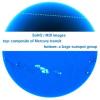
SIMLC

|
exeter astro | Suzanne Aigrain home |
|
SIMLC |
|
This is the webage for the SIMLC software package developped by Suzanne Aigrain at the Institute of Astronomy, University of Cambridge, UK. Last modified 03/06/2005. Contents
Description and conditions of use SIMLC is an IDL tool to simulate stellar light curves containing micro-variability, i.e. variability due to the rotational modulation and intrinsic evolution of structures of magnetic and convective origin at the surface of the star. It has been developped primarily to evaluate the impact of this type of variability on projects to search for exoplanets (planets outside the solar system) via the transit method from space. It is open source and freely available, under the GNU General Public License (GPL), i.e. you are free to use it, modify it and redistribute it as you wish so long as it is also under the terms of the GPL, and there is no garrantee whatsoever. If you use SIMLC, I would appreciate an email (suz at ast dot cam dot ac dot uk) to let me know, as I like to keep track of who uses it and what for, and so that I can keep you informed of upgrades. I would also appreciate any comments, feedback and suggestions for improvement. Please read carefully this page (especially the documentation and modification history section, and the documents which are mentioned in it) in detail, as there are many caveouts you should be aware of before using the software. Documentation and modification history SIMLC is based on fits to observations to the Sun's total irradiance variations and on emprical scaling laws, which are described in Aigrain, Favata & Gilmore (2004), A&A, 414, 1139. Since the publication of that paper, I have implemented several modifications:
The main program is SIMLC, whose calling sequence is: IDL> lc = SIMLC(tstep, dur, hjd=hjd, age=age, spt=spt, bv=bv, prot=prot, rhk=rhk, teff=teff, logg=logg, corot=corot, file=file, verb=verb. plot=plot) On output, lc is a 2xN or 6xN element array. The 0th column of corot keyword was set, there are 4 more columns, which contain the CoRoT white, red, green and blue bandpass light curves respectively, normalised to the median flux in the CoRoT white bandpass. The time array is defined by specifying either the tstep and dur arguments (time step in seconds, duration in number of time steps) or by setting the hjd keyword to a variable containing an array of time values in days. If the verb keyword is set, the program prints out information as it goes on. If the plot keyword is set, it plots the power spectrum and the light curve before returning. If you want the light curve to be saved to an ASCII file, set the file keyword to the filename you want it saved in. The format will be 1 column for time and 1 for the light curve in each bandpass. The first line contains the column titles and the second line the units, the data starts on line 3. The keywords age, spt, bv, prot, rhk, teff and logg refer to the star. age is the age in Myr, spt is the spectral type (should be one of F5, F8, G0, G2, G5, ..., K5), bv is the (B-V) colour in mag, prot is the rotation period in days, rhk is the log of the average Mt Wilson CaII H&K chromospheric activity index R'HK, teff is the effective temperature in Kelvin, and logg is the log of the gravitational acceleration in cm/s2. The model can work given only age and spectral type (dwarfs only) as input provided the spectral type is between F5 and K5 and the age larger than 625 Myr (Hyades age). All other necessary quantities are then deduced from those using the tables in Astrophysical Quantities (Allen 1973) and scaling laws described in Aigrain, Favata & Gilmore (2004a) and on this page. These deduced quantities are printed out if the verb keyword is set. However, each parameter can also be specified directly, using the other keywords, which allows one to escape the limits of age, luminosity class and spectral type if the necessary parameters of the stars are known. It would be too long here to list all the possible combinations of parameters which one can use. If SIMLC needs more information than it has been provided with, it will print and error message and return -1. Any keywords which are set to undefined variables on input and whose values are calculated by the program will contain the calculated values on output. I used SIMLC together with transit search and light curve filtering algorithms I developped during my PhD to estimate detection limits and identify favourable types of target stars for the (now defunct) ESA mission Eddington, and for the franco-European mission CoRoT. This is documented in Chapter 5 of my thesis. SIMLC was also used in both of the CoRoT blind tests. The first is documented in Moutou et al. (2005), A&A, 437, 355 and in Chapter 6 of my thesis, the second is in progress. SIMLC has been integrated in the COROTLux package, developped by Tristan Guillot (OCA, Nice) and collaborators to estimate the contamination of the CoRoT exoplanet signal by background eclipsing binaries. The CoRoT seismology working group are also considering using some of the scaling laws inherent to SIMLC as part of their own light curve simulation tools. |